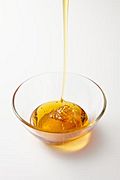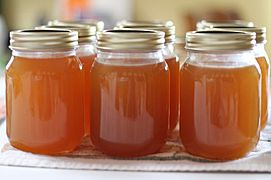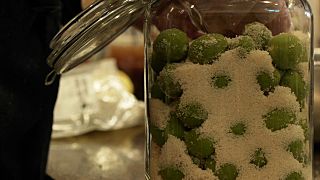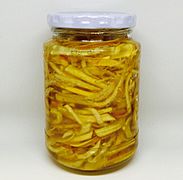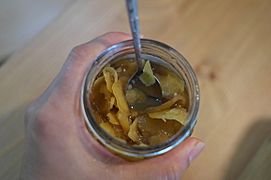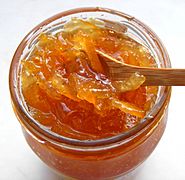Cheong (food) facts for kids
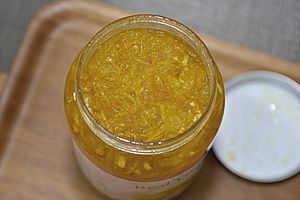
A jar of yuja-cheong
|
|
| Place of origin | Korea |
|---|---|
| Associated national cuisine | Korean cuisine |
| Similar dishes | |
| Korean name | |
| Hangul |
청
|
|---|---|
| Hanja |
淸
|
| Revised Romanization | cheong |
| McCune–Reischauer | ch'ŏng |
| IPA | [tɕʰʌŋ] |
Cheong (Hangul: 청; Hanja: 淸) is a name for various sweetened foods in the form of syrups, marmalades, and fruit preserves. In Korean cuisine, cheong is used as a tea base, as a honey-or-sugar-substitute in cooking, as a condiment, and also as an alternative medicine to treat the common cold and other minor illnesses.
Originally, the word cheong (Hangul: 청; Hanja: 淸) was used to refer to honey in Korean royal court cuisine. The name jocheong (Hangul: 조청; Hanja: 造淸; "crafted honey") was given to mullyeot (liquid-form yeot) and other human-made honey-substitutes. Outside the royal court, honey has been called kkul (Hangul: 꿀), which is the native (non-Sino-Korean) word.
Contents
Varieties
- Jocheong (조청; "crafted honey") or mullyeot (물엿; liquid yeot): rice syrup or more recently also corn syrup
- Maesil-cheong (매실청; "plum syrup")
- Mogwa-cheong (모과청; quince preserve)
- Mucheong (무청; radish syrup)
- Yuja-cheong (유자청; yuja marmalade)
Maesil-cheong
Maesil-cheong (Hangul: 매실청; Hanja: 梅實淸, [mɛ.ɕil.tɕʰʌŋ]), also called "plum syrup", is an anti-microbial syrup made by sugaring ripe plums (Prunus mume). In Korean cuisine, maesil-cheong is used as a condiment and sugar substitute. The tea made by mixing water with maesil-cheong is called maesil-cha (plum tea).
It can be made by simply mixing plums and sugar together, and then leaving them for about 100 days. To make syrup, the ratio of sugar to plum should be at least 1:1 to prevent fermentation, by which the liquid may turn into maesil-ju (plum wine). The plums can be removed after 100 days, and the syrup can be consumed right away, or mature for a year or more.
Mogwa-cheong
Mogwa-cheong (모과청 [mo.ɡwa.tɕʰʌŋ]), also called "preserved quince", is a cheong made by sugaring Chinese quince (Pseudocydonia sinensis). Either sugar or honey can be used to make mogwa-cheong. Mogwa-cheong is used as a tea base for mogwa-cha (quince tea) and mogwa-hwachae (quince punch), or as an ingredient in sauces and salad dressings.
Yuja-cheong
Yuja-cheong (Hangul: 유자청; Hanja: 柚子淸, [ju.dʑa.tɕʰʌŋ]), also called "yuja marmalade", is a marmalade-like cheong made by sugaring peeled, depulped, and thinly sliced yuja (Citrus junos). It is used as a tea base for yuja-cha (yuja tea), as a honey-or-sugar-substitute in cooking, and as a condiment.
Gallery
-
Deodeok-yuja-salad, a lance asiabell root salad with yuja-cheong-based dressings


